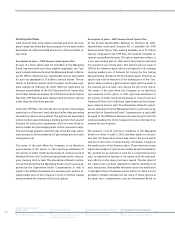Siemens 2009 Annual Report Download - page 285
Download and view the complete annual report
Please find page 285 of the 2009 Siemens annual report below. You can navigate through the pages in the report by either clicking on the pages listed below, or by using the keyword search tool below to find specific information within the annual report.
Managing Board statements, Independent auditors’ report, Additional information
Notes to Consolidated Financial Statements
(in millions of €, except where otherwise
stated and per share amounts)
ing activities. There are also a number of decentralized tools
used for management of individual credit risks within the op-
erating units. A central IT application processes data from the
operating units together with rating and default information
and calculates an estimate which may be used as a basis for
individual bad debt provisions. In addition to this automated
process, qualitative information is considered, in particular to
incorporate the latest developments.
To increase transparency on credit risk Corporate Treasury has
established in fiscal 2008 a “ Siemens Credit Warehouse”. Oper-
ating units with an initial emphasis on entities in Europe and
within the following year in North America, South America
and Asia transfer their current trade receivables, along with
the inherent credit risk, to the Siemens Credit Warehouse but
remain responsible for servicing activities such as collections
and receivables management. Siemens Credit Warehouse ac-
tively identifies, quantifies and manages the credit risk in its
portfolio, such as by selling or hedging exposure to specific
customers, countries and industries.
Credit risks arising from credit guarantees are described in
Note 29. There were no significant concentrations of credit risk
as of September 30, 2009.
Concerning trade receivables and other receivables, as well as
other loans or receivables included in Other financial assets
that are neither impaired nor past due, there were no indica-
tions as of September 30, 2009, that defaults in payment obli-
gations will occur. For further information regarding the con-
cept for the determination of allowances on receivables see
Note 3.
SHARE-BASED PAYMENT
Share-based payment plans at Siemens are designed as equity-
settled plans as well as cash-settled plans. Total pre-tax ex-
pense for share-based payment recognized in net income for
continuing and discontinued operations amounted to €212
and €91 for the years ended September 30, 2009 and 2008, re-
spectively, and refers primarily to equity-settled awards, in-
cluding the Company ’s employee share purchase program.
Credit risk
The Company is exposed to credit risk in connection with its
significant project business in many of its Sectors and also in
some Cross-Sector business fields as public infrastructure and
transport, healthcare, utilities and IT where direct or indirect
financing in various forms may be provided to customers. In
limited cases, the Company may also take an equity interest as
part of the project financing.
The Company is also exposed to credit risk via its financing ac-
tivities, primarily related to medical engineering, data process-
ing equipment and industrial products of third party manufac-
turers.
Credit risk is defined as an unexpected loss in cash and earn-
ings if the customer is unable to pay its obligations in due
time, if the value of property that serves as collateral declines,
or if the projects Siemens has invested in are not successful.
The current global financial crisis may cause customer default
rates to increase and collateral values to decline. The effective
monitoring and controlling of credit risk is a core competency
of our risk management system. Corporate Treasury has imple-
mented a binding credit policy for all Siemens segments and
entities. Hence, credit evaluations and ratings are performed
on all customers with an exposure or requiring credit beyond a
centrally defined limit.
Customer ratings, analyzed and defined by a designated SFS
department, and individual customer limits are based on gen-
erally accepted rating methodologies, the input from external
rating agencies and Siemens default experiences. Such ratings
are processed by internal risk assessment specialists. Ratings
and credit limits are carefully considered in determining the
conditions under which direct or indirect financing will be of-
fered to customers by the operating units.
Credit risk is recorded and monitored on an ongoing basis ap-
plying different approaches dependent on the underlying
product. Central systems are used for monitoring of operating
counterparty risk and real-time monitoring of treasury coun-
terparty risk. In addition SFS uses own systems for its financ-
























